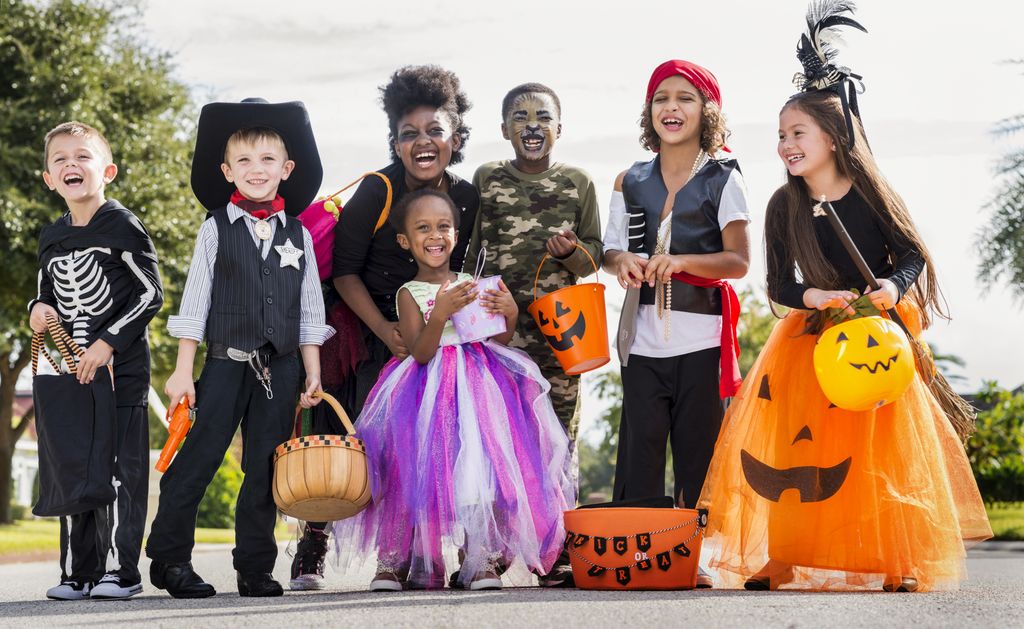Halloween street smarts
- Always accompany young children on their neighborhood rounds. If trick-or-treating doesn’t start until after dark where you live, consider checking with your town or park district for Halloween activities offered earlier in the day. Research shows that evenings from 6 p.m. to 9 p.m. are the riskiest times of day for child pedestrians.
- If your older children are trick-or-treating alone, plan and review the route that is acceptable to you. Agree on a specific time when they should return home and get flashlights with batteries for everyone.
- Talk with kids about the risk of distracted walking. This includes text messaging, talking on or looking at the mobile phone and listening to music.
- Cross the street as a group in established crosswalks. Most (62%) child pedestrian traffic fatalities occurred mid-block, rather than at intersections. Make sure kids know not to cross the street between parked cars or out of driveways or alleys.
- Don’t assume cars will stop just because they have the right of way. Motorists may have trouble seeing trick-or-treaters.
- Stay on well-lit streets and always use the sidewalk. If no sidewalk is available, walk at the far edge of the roadway facing traffic. Only go to homes with a porch light on and, ideally, a well-lit pathway.
Preparing your home for trick-or-treaters
- Remove tripping hazards to keep your home safe for visiting trick-or-treaters. Keep the porch and front yard clear of items such as garden hoses, toys and bikes.
- Check outdoor lights and replace burned-out bulbs.
- Sweep wet leaves from sidewalks and steps to prevent anyone from slipping on them.
- Restrain pets so they do not jump on or bite a trick-or-treater.
Costume safety tips
- Plan costumes that are bright and reflective. Consider adding reflective tape or striping to costumes and trick-or-treat bags for greater visibility.
- Make sure that shoes fit well, and that costumes are short enough to prevent tripping, getting caught on objects or coming into contact with firepits.
- Look for “flame resistant” on the costume labels. Wigs and accessories should also clearly indicate this.
- Hats should fit properly to prevent them from sliding over eyes and blocking vision.
- Consider non-toxic makeup and decorative hats as safer alternatives to masks. Test makeup ahead of time on a small patch of your child’s skin to ensure there are no unpleasant surprises or allergic reactions on the big day. Toxic ingredients have been found in cosmetics marketed to teens and tweens.
- Avoid any sharp or long swords, canes or sticks as a costume accessory. Your child can easily be hurt by these accessories if he or she stumbles or trips.
- Do not use decorative contact lenses without an eye exam and a prescription from an eye care professional. While packaging for decorative lenses may claim “one size fits all,” or “no need to see an eye specialist,” wearing decorative contact lenses without a prescription is dangerous. It can cause serious eye problems that can lead to permanent vision loss.
Pumpkins & decorating safety
- Never allow small children to carve pumpkins. Children can draw a face with markers. Parents can do the cutting and then let little ones clean out the inside pulp and seeds. The American Society for Surgery of the Hand offers safe carving tips.
- Consider using a flashlight or glow stick instead of a candle to light your pumpkin. If you do use a candle, a votive candle is safest.
- Do not place candlelit pumpkins on a porch or any path where visitors may pass close by. They should never be left unattended.
Healthy Halloween tips
- Consider offering non-edible goodies to trick-or-treaters. Halloween is one of the trickiest days of the year for children with food allergies. Food Allergy Research & Education’s Teal Pumpkin Project suggests items such as glow sticks, spider rings, vampire fangs, pencils, bubbles, bouncy balls, finger puppets, whistles, bookmarks, stickers and stencils.
- Wait until children are home to sort and check treats before eating them. Though tampering is rare, it can happen. Also, many cannabis edibles look like regular candy could get accidentally mixed up with Halloween treats. Closely examine all treats and throw away any spoiled, unwrapped or suspicious items. Give your child a good meal before trick-or-treating to discourage sampling.
- Keep an eye on what your child has in their mouth at all times while trick-or-treating. Keep in mind that babies and toddlers should not have hard candies, caramel apples, popcorn, gum, small candies (jellybeans, etc.), gummy candy, pumpkin seeds or anything with whole nuts. Candy wrappers, stickers, small toys or temporary tattoos can be a choking hazard, too.
At Rising Stride Child Care Centers, your child will build a strong educational and social foundation – with all the fun of childhood mixed in. Our programs focus on school readiness, social, emotional and intellectual development, and what every child needs – love and care!

